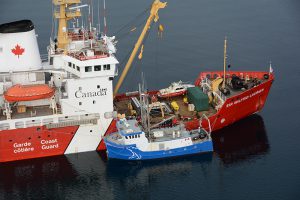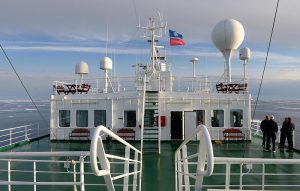
History
2014 Victoria Strait Expedition
This year's search is about much more than underwater archaeology. The Victoria Strait Expedition will contribute to northern science and communities.
- 1205 words
- 5 minutes
This article is over 5 years old and may contain outdated information.
History

August 30, 2014, 23:00 Mountain Standard Time
Today is the Laurier’s official start date on the Victoria Strait Expedition!
The day was dedicated to transits, transfers and tramping. The first operation this morning saw the Martin Bergmann come alongside the Laurier for scheduled refueling and a top-up of freshwater. It was great to touch base with our colleagues and their captain Dave McIsaac before the Bergmann headed back to the southern search area where their combined crew from Parks Canada, the Royal Canadian Navy and the Arctic Research Foundation are making significant inroads in their side-scan surveys. I had a mug-up with captain McIsaac, who is also a commercial fisherman from the East Coast. Trading yarns with this experienced Newfoundland captain made for a great start to the day.

Following that task, we set course for Jenny Lind Island at the southern end of Victoria Strait where we met up with our partners aboard the One Ocean Voyager to complete the transfer of the Parks Canada dive tender Investigator and the remotely operated vehicle. This was a delicate operation that first required the 83-metre Laurier to pace slowly into position along the slowly moving starboard side of the 117-metre Voyager. I knew beforehand that the larger ship was going to test the reach of our crane, and the location of the Investigator on their aft deck meant that we couldn’t secure alongside with the starboard side of our ship, which is cluttered with a science A-frame and the hydrographic survey launches. We mapped out the lift in advance using Autoload stability software to verify the height and reach of the crane, and then prepared to put our plan into action.
We set up only one spring line, lots of fenders, and managed to station-keep while supported by crewmembers on deck. Boatswain Rhett Miller and winchman Cory Glencross coordinated the delicate crane operations that saw the carefully maneuvering of the Investigator from the aft deck of Voyager and into a cradle on the port side of the Laurier. Watching from the bridge, I worked with my chief officer to manage the position of the ship and ensure the safe transfer of cargo. I was so proud to watch our expert deck crew adapting so effectively throughout the operation, especially considered the space constraints, the crane at full reach and the reality that it was being conducted between ships underway together in the Arctic. I’m sure that the many photographers and film crew who caught the action were equally impressed.
Our well deck is now at full capacity, with the two seven-metre CHS launches Gannet and Kinglett and the Parks Canada 10-metre Investigator tightly arranged around our hatch. And I shouldn’t forget to mention the toys stored in the hold, including both the autonomous underwater vehicle and the remotely operated vehicle that Parks Canada brought up, in addition to our own ROV. The planning phase is now officially over, and our limitations now relate only to the number of crew available to operate the assets, the weather, and as always, the ice.
With all transfers completed, I planned on this being enough activity for the day. But by 8:30 pm local time, we headed off instead to the southwest to provide advice and an ice escort to a container ship in the area. Our icebreaking will continue late into the night, and once done, we will turn around toward our start point at the southern entrance of Alexandra Strait and resume our role in the Victoria Strait Expedition. Now off to work with all our toys to find those ships. I think I have Franklin fever.
Are you passionate about Canadian geography?
You can support Canadian Geographic in 3 ways:

History
This year's search is about much more than underwater archaeology. The Victoria Strait Expedition will contribute to northern science and communities.

History
Introductory insights into the Canadian Coast Guard’s role in the search area

History
First official day of the 2014 search for Sir John Franklin’s lost ships

People & Culture
On April 12, Franklin enthusiasts had a rare opportunity to come together in the same room as The Royal Canadian Geographical Society presented their 2016 Can Geo Talks